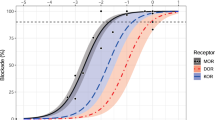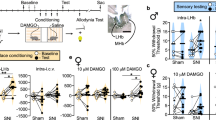Abstract
RECENT studies have revealed the existence of endogenous morphine-like compounds in the central nervous system1–3 and in the pituitary4. These compounds, named enkephalin1 and C-fragment4, have been reported to produce analgesia when injected intraventricularly in rats and cats5,6 and to be antagonised by naloxone which is a potent antagonist of narcotic analgesics. They also have a high affinity for the opiate receptor, which has been discovered in the central nervous system of vertebrates including man7, and they can displace naloxone from these receptors2–4. There is substantial evidence that central grey structures in the midbrain are intimately involved in analgesia. Electrical stimulation8 and microinjection of morphine9,10 in these regions produce analgesia which is antagonised by naloxone. Stimulation of the central grey region in humans11 has been reported to produce marked analgesia which is antagonised by small doses of naloxone12. In addition, acupuncture analgesia has been reported to be antagonised by naloxone13. These findings have led to the hypothesis that there may be an ongoing release within the brain of a morphine-like compound which is partially responsible for pain thresholds. If this were so, then the antagonism of the effects of the endogenous compound by naloxone should affect pain perception. The experiments reported here demonstrate that the perception of experimentally induced pain in normal human subjects is not altered by administration of the opiate antagonist naloxone.
This is a preview of subscription content, access via your institution
Access options
Subscribe to this journal
Receive 51 print issues and online access
$199.00 per year
only $3.90 per issue
Buy this article
- Purchase on Springer Link
- Instant access to full article PDF
Prices may be subject to local taxes which are calculated during checkout
Similar content being viewed by others
References
Hughes, J., et al., Nature, 258, 577–579 (1975).
Terenius, L., and Wahlström, A., Acta physiol. scand., 94, 74–81 (1975).
Pasternak, G. W., Goodman, R., and Snyder, S. H., Life Sci., 16, 1765–1769 (1975).
Bradbury, A. F., Smyth, D. G., Snell, C. R., Birdsall, N. J. M., and Hulme, E. C., Nature, 260, 793–795 (1976).
Beluzzi, J. D., et al., Nature, 260, 625–626 (1976).
Feldberg, W., and Smyth, D. G., J. Physiol., Lond., 260, 30P–31P (1976).
Pert, C. B., and Snyder, S. A., Science, 179, 184–188 (1973).
Mayer, D. J., and Liebeskind, J. C., Brain Res., 68, 73–93 (1974).
Jacquet, Y. F., and Lajtha, A., Science, 182, 490–492 (1973).
Pert, A., and Yaksh, T., Brain Res., 80, 135–140 (1974).
Richardson, D. E., IEEE Trans. Bio. Med. Eng., 23, 304–306 (1976).
Adams, J. E., Pain, 2, 161–166 (1976).
Mayer, D. J., Price, D. D., and Raffi, A., First World Congr. on Pain, Advances in Pain Research and Therapy, 1 (Raven, New York, in the press).
Tursky, B., Watson, P. D., and O'Connell, D. W., Psychophysiology 1, 296–298 (1965).
Winthrop Lab. Data sheet for Narcan (1974).
Parry, L. W., Smith, G. M., and Denton, J. E., Anesthesia and Analgesia, 51, 573–577 (1972).
Goldstein, A., Pryor, G. T., Otis, L. S., and Larsen, F., Life Sci., 18, 599–604 (1976).
Melzack, R., The Puzzle of Pain (Penguin, Harmondsworth, 1973).
Author information
Authors and Affiliations
Rights and permissions
About this article
Cite this article
EL-SOBKY, A., DOSTROVSKY, J. & WALL, P. Lack of effect of naloxone on pain perception in humans. Nature 263, 783–784 (1976). https://doi.org/10.1038/263783a0
Received:
Accepted:
Issue Date:
DOI: https://doi.org/10.1038/263783a0
This article is cited by
-
Naloxone as an antidote for angiotensin converting enzyme inhibitor poisoning: a case report
Canadian Journal of Anesthesia/Journal canadien d'anesthésie (2020)
-
Anti-nociceptive and anti-inflammatory actions of sulforaphane in chronic constriction injury-induced neuropathic pain mice
Inflammopharmacology (2017)
-
Psychological coping with acute pain: An examination of the role of endogenous opioid mechanisms
Journal of Behavioral Medicine (1996)
-
La complexité des systèmes opioïdes endogènes mise en évidence par les effets de l’injection systémique de naloxone chez un modèle expérimental de douleur, le rat arthritique
Douleur et Analgésie (1988)
-
Effects of aspirin, naloxone and placebo
Clinical Rheumatology (1987)
Comments
By submitting a comment you agree to abide by our Terms and Community Guidelines. If you find something abusive or that does not comply with our terms or guidelines please flag it as inappropriate.



